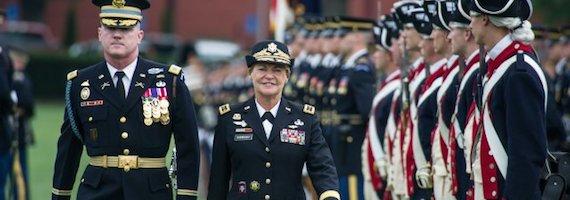During my Army career, first on active duty and later in the Reserves, the Army Birthday was one of those things that usually meant a piece of cake and back to work.
But this year I’ve been listening to my goddaughter’s sister talk excitedly about entering West Point a few weeks from now. Thinking about how far the Army has come since I was her age, especially as far as women are concerned, I actually feel like celebrating.
Inclusion
THEN: I did not go to West Point. It wasn’t even on my radar screen back then--not the military, not West Point.
Even if I had dreamed of going to the United States Military Academy at West Point, I couldn’t. The military academies didn’t start accepting women until 1976, the year afer I graduated from college.
 I entered the Army through a direct commission program that commissioned college graduates as second lieutenants, putting them through an eleven week Women’s Officer Orientation Course at Ft. McClellan Alabama.
I entered the Army through a direct commission program that commissioned college graduates as second lieutenants, putting them through an eleven week Women’s Officer Orientation Course at Ft. McClellan Alabama.
Since women had just started in ROTC programs at that time, the only source of female officers back then was either OCS or this direct commission program. And yes, we were still WACs, the separate Women’s Army Corps that disbanded a few years later, in 1978.
Things have changed a lot since then. I’m only describing a few of those changes. I bet any military member or veteran reading this can list so many things that have changed since you were enlisted or commissioned.
Uniforms
THEN: We wore cords, a light green skirt and fitted top. They certainly weren’t very conducive to work in because they wrinkled so badly. Every women’s restroom in our office buildings had an ironing board set up with an iron ready to use. You had to stop in a couple of times a day to take off and iron your skirt.
I’ll also never forget the ugly mint green polyester jumper that replaced the cords, followed by a dark geen pantsuit that at least had comfort going for it.
I used to tell civilian friends that my Army Class A green uniform was one of the more expensive and ill-fitting suits I’ve owned. It never was comfortable.
At least over time, our uniforms mirrored those of the men so we weren’t separated out as much. However, trying to pin on nameplates, US Army plates and ribbons was always a challenge to us women compared to men. Those curves have an impact on straight lines. I envied how easy it was for my husband to get his uniform jackets ready.
NOW: Ironically, I understand the Army is creating a new female-only Army Combat Uniform, to allow for the differences in our body types.
Weapons training
THEN: We were in the first class of WACs to receive mandatory weapons training with the M16 rifle. Just a year later, training in grenade launchers, M60 machine guns and claymore mines was added. Just two years later, combined basic training of men and women became policy.
NOW: Women are already training with a High Mobility Artillery Rocket System (HIMARS) crew at Ft. Bragg in preparation for the opening of combat roles to women in 2016.
Promotion Opportunities
THEN: There were only two women generals in the Army and they were capped at the one star level. Of course we sat around and discussed who among our coursemates might make general someday. Ann Dunwoody was at the top of our list. She seemed to excel at everything. None of us could have imagined she’d eventually become the first female four-star general in the U.S. military in 2008.
NOW: Gen. Dunwoody said at her promotion, “I might be the first, but I won’t be the last.” Air Force officer Janet Wolfenbarger became the second female four-star general in the history of the U.S. military in June 2012.
Rememberance
This reminiscing makes me think of a conversation I had with a fellow young Army Reservist just prior to the dedication of the Women in Military Service to America (WIMSA) memorial in October 1997.
“Why do we need a women’s memorial?” she asked when I told her about WIMSA. “We’ve worked so hard to be treated equal to men — we aren’t ‘women in the military,’ we are soldiers — why would we want to have a separate memorial?”
I’d felt ambivalent about WIMSA at first too. I didn’t see the need. Until I met all those female WWII vets. One year, during three days of Veterans Day activities in Albany, Salem, and Portland, Oregon, I talked to many women who were WWII vets, some of the 400,000 women who served in the U.S. and overseas during that war. I heard the pride in their voices and the concern that they wouldn’t be remembered — that their sacrifices would be ignored.
I hadn’t really known their stories until then, hadn’t realized how much ground-paving they did to allow women in my generation greater opportunities.
NOW: I doubt that most women entering the military today realize that we used to be part of a separate group within the Army, with our numbers capped at 2%, with very few specialties open to women, with a requirement to leave the service if you got pregnant.
On the Army’s birthday, I think it is important to remember where the Army was when each of us joined and what the Army is doing now. But most of all, we need to think of where the Army is going next for all our future generations.
Kathie Hightower is a longtime military spouse. With her cohort Holly Scherer she’s presented Follow Your Dreams While You Follow the Military™ workshops for military spouses worldwide. Coauthor of Military Spouse Journey: Discover the Possibilities and Live Your Dreams, and 1001 Things to Love About Military Life, along with many columns and articles. Find more about Military Spouse Journey on Facebook here.









